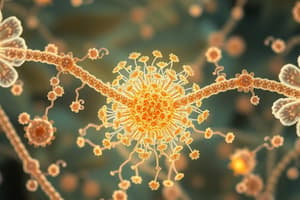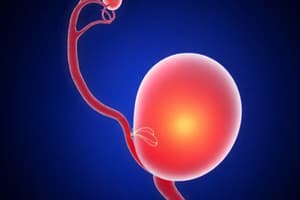Podcast
Questions and Answers
What is the primary function of the amnion during development?
What is the primary function of the amnion during development?
- Nutrient absorption
- Creating the neural tube
- Connecting the fetus to the placenta
- Producing amniotic fluid (correct)
The mesoderm develops into the nervous system.
The mesoderm develops into the nervous system.
False (B)
What induces the formation of the neural folds during neurulation?
What induces the formation of the neural folds during neurulation?
Notochord
Teratogens can cause __________ in the developing embryo.
Teratogens can cause __________ in the developing embryo.
Match the following germ layers with their primary derivatives:
Match the following germ layers with their primary derivatives:
Which of the following describes fetal hemoglobin (HbF)?
Which of the following describes fetal hemoglobin (HbF)?
The foramen ovale is one of the shunts in fetal circulation that connects the umbilical vein to the inferior vena cava.
The foramen ovale is one of the shunts in fetal circulation that connects the umbilical vein to the inferior vena cava.
What are stem cells capable of?
What are stem cells capable of?
During birth, the cervix __________ out and the amniotic sac ruptures.
During birth, the cervix __________ out and the amniotic sac ruptures.
Which maternal condition is known to affect fetal development and can lead to hypoglycemia after birth?
Which maternal condition is known to affect fetal development and can lead to hypoglycemia after birth?
What is the process of fertilization?
What is the process of fertilization?
Identical twins result from the fertilization of two eggs by two different sperm.
Identical twins result from the fertilization of two eggs by two different sperm.
What prevents additional sperm from fertilizing the egg after the first sperm penetrates?
What prevents additional sperm from fertilizing the egg after the first sperm penetrates?
The _____ is a solid mass of cells seen in early development.
The _____ is a solid mass of cells seen in early development.
Match the following twin types with their definitions:
Match the following twin types with their definitions:
What structure becomes the developing organism within the blastula?
What structure becomes the developing organism within the blastula?
Indeterminate cleavage results in cells committed to becoming specific cell types.
Indeterminate cleavage results in cells committed to becoming specific cell types.
What is the role of the allantois during early development?
What is the role of the allantois during early development?
The _____ contains chorionic villi that create the interface between maternal and fetal blood.
The _____ contains chorionic villi that create the interface between maternal and fetal blood.
Which stage follows the first cleavage, changing the zygote into an embryo?
Which stage follows the first cleavage, changing the zygote into an embryo?
Flashcards are hidden until you start studying
Study Notes
Fertilization and Early Development
- Fertilization occurs when a sperm joins an ovum, typically in the ampulla of the fallopian tube.
- Acrosomal enzymes help the sperm to penetrate the protective layers surrounding the egg.
- The cortical reaction, triggered by the first sperm's penetration, releases calcium ions to prevent polyspermy and increases the zygote's metabolic rate.
- Fraternal twins arise from two separate eggs fertilized by different sperm, while identical twins originate from a single zygote that splits.
- Cleavage is the series of rapid mitotic divisions of the zygote, resulting in smaller cells without overall volume increase.
Embryonic Structures
- The blastula, or blastocyst, contains a blastocoel and differentiates into the trophoblast (future placenta) and the inner cell mass (future organism).
- Placental formation begins with the implantation of the blastula in the endometrial lining.
- Chorionic villi penetrate the endometrium and establish maternal-fetal blood exchange; the yolk sac supports the embryo pre-placenta.
- The amnion produces amniotic fluid, providing a protective environment for the developing organism.
Germ Layer Formation
- Gastrulation forms the archenteron, leading to the establishment of three primary germ layers: ectoderm, mesoderm, and endoderm.
- Ectoderm develops into skin, nervous system, and sensory organs; mesoderm forms musculoskeletal, circulatory, and excretory systems; endoderm develops into epithelial linings of the respiratory and digestive tracts.
Nervous System Development
- Neurulation, the process of nervous system formation, begins with the notochord inducing neural folds which form the neural tube, precursor to the central nervous system.
- Neural crest cells contribute to the peripheral nervous system and specialized tissues.
Teratogens and Maternal Influences
- Teratogens are agents that can cause developmental abnormalities, including alcohol, certain drugs, and infections.
- Maternal conditions like diabetes can lead to increased fetal size, while folic acid deficiency can cause neural tube defects.
Cell Specialization and Signaling
- Determination commits cells to specific lineages influenced by morphogens; differentiation alters cells through selective transcription.
- Stem cells possess different potencies: totipotent cells can form all cell types, pluripotent cells can become germ layers, and multipotent cells form specific types.
- Different signaling mechanisms such as autocrine, paracrine, juxtacrine, and endocrine ensure communication in cellular development.
Apoptosis and Regenerative Capacity
- Apoptosis is programmed cell death that shapes developing structures, while regenerative capacity varies; the liver exhibits high, but the heart shows low regenerative abilities.
- Senescence occurs due to telomere shortening and other metabolic changes with cell divisions.
Fetal Circulation
- Nutrient and gas exchange between mother and fetus occurs via the placenta, with fetal hemoglobin having a higher oxygen affinity than adult hemoglobin.
- The placenta also serves as an endocrine organ, secreting key hormones necessary for pregnancy maintenance, while providing immunological protection.
- Fetal circulation includes three shunts: the foramen ovale, ductus arteriosus, and ductus venosus which bypass non-functional lungs and liver.
Gestation and Birth
- The first trimester is critical for organogenesis, while the second and third trimesters involve significant growth and development, including antibody transfer to the fetus.
- Birth involves cervical effacement and rupture of the amniotic sac, followed by coordinated contractions that lead to delivery and expulsion of the placenta.
Studying That Suits You
Use AI to generate personalized quizzes and flashcards to suit your learning preferences.




